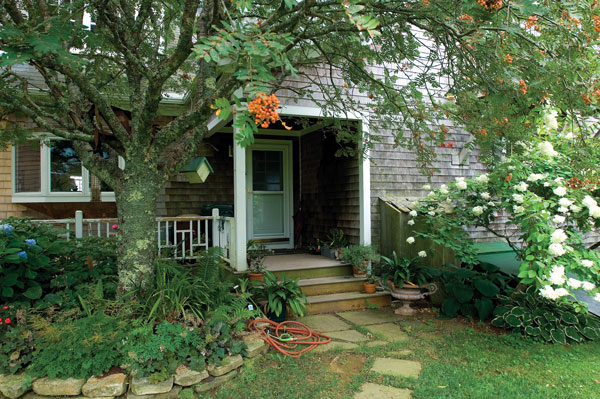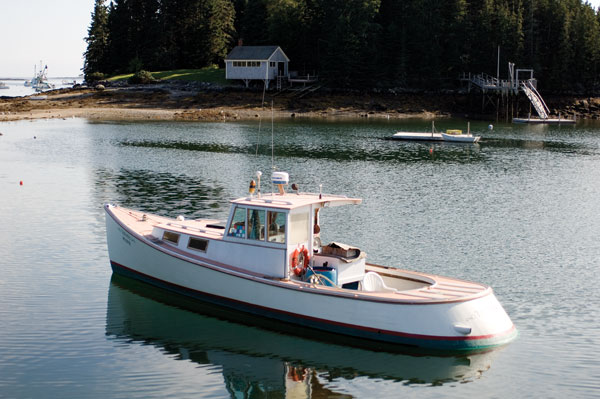A Family Affair
August 2009
by Debra Spark
Photography François Gagné
Designing for generations
When Ariana Fischer-Gregg was 22, she took the Johnson O’Connor aptitude test. Her credentials were in order—her years at boarding school and Boston University behind her—but what were her natural talents? “High aesthetics,” she remembers the test concluding. “Long-term vision. You should own your own business or sell pretty things.” Could these results have been a surprise? Given Ariana’s lineage? Her childhood? Probably not.
Ariana descends from several generations of artists and patrons of the arts. In the artist column: her father (a sculptor), her uncle (a children’s book illustrator), her grandfather (an architect and Russian émigré, much influenced by Walter Gropius and Marcel Breuer). In the collector column? All of the above, plus Olga Pertzoff, Ariana’s maternal grandmother, a member of mid-twentieth-century Boston society, given to flamboyant dress and the hosting of costume balls and theatricals, but also to the procurement of Danish modern furniture and Picasso prints, before either was fashionable. Other collectors? Well, why not extend the family tree out and name the name? Ariana’s grandmother’s aunt happened to be Isabella Stewart Gardner, whose Boston museum—modeled after a fifteenth-century Venetian palace—has exhibited some of the world’s most famous painters since its opening in 1903. When it comes to procuring art, Ariana’s is a family that knows what it’s doing. As for Ariana, what’s she’s doing is interior design, under the auspices of G.F. MacGregor, her Rockland design studio and high-end retail store. Her projects run the gamut but often focus on homes that reflect the lives (and needs) of multiple generations, including, in the past few years, the home of her parents, Julian and Tatiana Fischer.
For years, the small fishing village of Port Clyde was where Ariana’s parents stopped when sailing from their summer home—on an island off Jonesport—to Portsmouth, New Hampshire, the harbor closest to the Vermont farm where they wintered. In the late 1980s, when the Fischers first considered relocating to Port Clyde, Tatiana tried to find someone in the area who sold real estate. She had no luck, until she got hold of the postmistress, who suggested Carl Schwab, a local lobsterman who dabbled in real estate. Nothing presented itself immediately, but eventually Carl said, “I got to thinking about it. My good friend Allison has mentioned a couple of times now that his girls are grown up, it might be fun to build a new house for himself and his wife. I’ll show you his place.”
Allison Wilson’s “place” was on a small peninsula overlooking Port Clyde harbor. A well-known old hotel—the Wawenock—once stood on the site, but when Allison acquired the property in the early 1960s, a rehab was financially prohibitive. Instead, he disassembled the place and built a ranch home for himself and his family. It was into this ranch home that Carl marched Tatiana. She laughs as she remembers the day. “Ruth, Allison’s wife, had just finished cleaning, and she’s watching her favorite soap opera with her second cup of coffee.” She had no idea her husband was thinking of moving, until Carl came in saying, “I’m just going to show the house.”
The first thing that Julian and Tatiana did after they purchased the house was, as they say, “de-ranch” it. A new, more steeply pitched roof helped them gain a second floor, into which they put three bedrooms and an office. Other add
itions and renovations turned the home into a cedar-shingled Cape. As for the property as a whole, some parts of the old hotel remain, like the boat house down on the wharf, where gentleman were supposedly once sent to smoke, and an octagonal annex behind the house, which (rumor has it) was once a ladies’ teahouse.
In designing the interior of her parents’ home, Ariana had the challenge of visually reconciling her parents’ many objects and collections, some of which they’ve inherited and others that they’ve procured on their own. On the one hand, the Fischers’ house has clean lines, and rooms that are easy to read. (“Understanding,” Ariana says. “That’s what brings comfort.”) On the other, the house incorporates many seemingly discordant items. Take the living room. How, exactly, to reconcile a giant Spanish trunk, which once held five generations of wedding dresses, Russian samovars, Old Master paintings, modernist furniture and Julian’s wood carving of John Singer Sargent’s famous portrait of Isabella Stewart Gardner? How to combine all that given Julian and Tatiana’s love of mixing woods? The living room has a cherry fireplace, and the floor is “tiled” with bricks formed out of the endgrain of oak. The trick, Ariana says, is “to pull some common threads together.” If, as she says, her family’s various tastes and belongings are limbs on a tree, her role is to provide the trunk.
An upstairs guest bedroom provides an example of how this works. Tatiana’s favorite color is purple. Her first language is Russian. She owns Russian icons and Imperial Coronation scenes. Outside her windows: a seawall and a lobster harbor, an extensive flower garden and spruce trees. Her furniture? Shaker or nineteeth-century New England. In describing the design challenge, Ariana says, “It’s as if someone handed you a lot of ingredients, and you’re not really sure how they are going to taste together. What are the juiciest ingredients? What are the dominant flavors? Make them bigger and see h
ow other things fit.” So for the bedroom she decided to “do the whole Russian opulent thing. Give it a great look with purples and all that, but do it with an austere New England bent.” The result is a room dominated by a sleigh bed with a griffin head (at the bed’s tail end) and griffin feet for legs. An old family item—a plum-colored velvet throw—sits at the foot of a bed otherwise covered in Belgian linen in shades of red and magenta. Russian items—turquoise enamel teacup, dinner bell, saltshaker and spoon—sit on a late-Empire dresser. Family trinkets—Japanese dolls from a sister’s time aboard, Olga’s elaborate hair combs —clutter a glassed-in cabinet that is fronted by a desk mask that Harold Tovish made of Hyman Bloom. An Louis XV-style armchair sits nearby. Its mossy green fabric manages to accentuate the richness of the room, while the wood frame makes its nod to the New England theme. Portrait frames of Fischer forebearers do the same. Contemporary bookcases and botanical prints lighten the feel of the whole room, while a vibrant contemporary painting of a blue dog—hung not at eye but at knee level—sits behind the armchair. Blue would seem to be the last color one would want to throw into the mix here, but somehow it works.
Throughout the house, Ariana has made use of bold fabrics to tie together a room or to rejuvenate an old piece of furniture. For instance, Julian and Tatiana’s three daughters—now all grown and
with children of their own—had fond feelings for the family’s Saarinen womb chair. But the chair, with its scratchy original wool, was not something that Tatiana particularly liked. For some people, Ariana points out, “Inherited stuff is a noose around the neck.” For her, it’s a bit of a puzzle: How can you make it fit? Ariana updated the chair with a William Yeoward fabric of interlocking blue and tan gear-shaped flowers—using pattern for a chair rarely done up in pattern—and now it’s a beloved chair again.
After she took her long-ago aptitude test, Ariana went to work at the DeCordova Museum in Lincoln, Massachusetts. While there, she was struck by the museum’s outdoor sculpture, particularly how the work degraded over time. And it is so with her interior design: it isn’t meant to be humidity, grandchildren, or sunlight proof. She’d rather, she says, “embrace the temporality of things,” which might be a surprising thought, given that her parents’ home is full of objects from the past. Or maybe this impulse is—like so much of what Ariana finds when she works on homes that reflect the lives of several generations—simply “another funny ingredient in the soup.”











